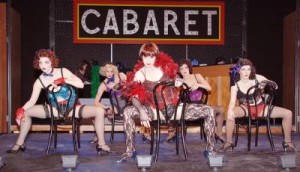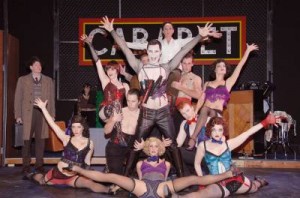
When a musical has been around as long as John Kander and Fred Ebb’s
Cabaret has (the original Broadway production opened in 1966), it becomes a
show that most veteran theatergoers have seen multiple times. Thus,
whenever a new production opens, it is up to the performers and director to
keep it fresh and vital. I’m pleased to report that International City Theatre’s
Cabaret features a trio of fine lead performances and a director whose
concept and vision distinguish this Cabaret from others which have come
before.
If ever there was a Broadway musical which benefited from a revival/revisal, it
is Cabaret, which director Sam Mendes “reinvented” in 1998. I saw a CLO
production of the original Cabaret about 15 years ago and found it rather a
bore. Not so the darker, sexier revival version, which directors now use as their
starting off point.
ICT’s is my fourth Cabaret since 2003 but my first time experiencing it in a mid-
sized theater. Though not of the scale and scope that the show would
receive were it performed by one of our CLOs (there are 7 Kit Kat Girls and Boys
here vs. 10 in the Broadway revival), it is still a step “bigger” than the Equity
Waver productions I’ve seen, and as this Cabaret illustrates, the show perhaps
lends itself best to a mid-sized house.
Director Jules Aaron stages Cabaret as if American writer Clifford Bradshaw’s
experiences in pre-WWII Berlin were being reenacted on the center stage of
the Kit Kat Club, while to its left and right, cast members not involved in the
scene being performed remain mostly onstage, seated either at the bar or in
front of the WCs. Kit Kat Girls and Boys (and other characters) move set pieces
(quickly I might add) during scene changes, then return to their seats,
becoming frozen tableaux as, center stage, the new scene is being performed.
Director Aaron deserves credit for many original touches in this new
production. Sally stirs her morning after raw egg with a bobby pin she pulls from
her hair, landlady Fraulein Schneider wipes tables in the Kit Kat Club (a logical
way for her to supplement her income), and “Tomorrow Belongs To Me” is sung
by the Kit Kat Boys and the Emcee in exquisite four part harmony. There’s also
the Emcee’s occasional companion, a ventriloquist’s dummy named Leslie,
who figures in several musical numbers, including the Act 1 finale, which leaves
the Emcee and Leslie standing alone downstage long after the houselights
have come up, staring eerily at the audience as they rise from their seats
(some of them doubtlessly uncomfortably) for intermission. In Act 2, the Kit Kat
Boys become Nazi soldiers lurking evilly behind the scenes. For the
Dietrichesque “I Don’t Care Much,” the Emcee emerges suddenly from a
coffin-sized crate which has been on stage at various times during the show,
the resemblance to a coffin becoming even more disquieting when we see its
red silk interior as part of the show’s chilling finale. Sally takes a snort of cocaine
and Cliff, who has just been beaten up by Nazi thugs, remains lying
unconscious on stage as Sally begins “Cabaret,” visibly altered by drugs and
alcohol. Finally, there is Aaron’s ending, which foreshadows the Nazi death
camps to come.
Erin Bennett is Sally Bowles, the “Life is a Cabaret” English girl who sings at a
1930 Berlin club known as the Kit Kat and who plans someday to “go like Elsie,”
a girl who died from “too much pills and liquor.” Bennett, who is known
primarily for straight plays (I’ve seen her in three of these at the Pasadena
Playhouse) proves herself a capable singer/dancer as well, with her dramatic
experience serving her well in creating a Sally whose carefree exterior is but a
façade for a complex and deeply sad young woman. Bennett gets to perform
some of the best songs Kander and Ebb ever wrote (“Don’t Tell Mama,” “Mein
Herr,” “Maybe This Time,” and of course the title song), and she sells them all.
Her British accent is flawless.
Christopher Carothers hits all the right notes in the role of Clifford Bradshaw,
the bisexual (with the accent on gay) writer whose arrival in Berlin coincides
with the rise of the Nazi party. Carothers has a lovely tenor, which is perhaps
the reason that the romantic “Why Should I Wake Up” from the original
production was reinserted into this one.
Finally, there is the show stopping role of the Emcee, immortalized on stage
and screen by diminutive Joel Gray, and which won pixyish Alan Cumming the
Tony in 1998. Here, the role goes to handsome Jason Currie, proving that his
standout performance in the recent Naked Boys Singing movie was no fluke.
Younger, considerably taller, and less of a clown than is usually the case,
Currie’s Emcee reminded me of a statuesque androgynous Marlene Dietrich in
male drag, at one point donning a black bra and panties for a high-kicking
chorus line number with the Kit Kat girls. Currie’s boy-next-door (with an edge)
persona makes for an Emcee perhaps less blatantly creepy than the role is
often played, but no less effective. Currie brings his Julliard-trained voice to
signature Emcee numbers like “Wilkommen,” “Money,” “If You Could See Her,”
and a particularly gorgeous “I Don’t Care Much.”
Bob Fosse’s 1972 film removed the “character songs,” with Liza Minnelli and
Joel Gray singing all the musical numbers as nightclub performances. In the
stage version, there are a number of songs which, in musical theater tradition,
take the place of dialog, and two of Cabaret’s supporting characters benefit
especially from this. Fraulein Schneider is played by Eileen T’Kaye, subdued until
she pulls out all the stops in “What Would You Do?” Herr Schultz, the Jewish fruit
merchant whom Fraulein Schneider agrees briefly to marry, is portrayed by a
sweet and touching Paul Zegler. Together they sing the charming “It Couldn’t
Please Me More (Pineapple Song)” though Schultz’s “Meeskite” was removed
from the Broadway revival and resulting productions.
Joshua Ziel’s Ernst is so ingratiating that it is all the more shocking when, as a
budding Nazi, he turns ugly. Kimberly Irion is a sassy Fraulein Kost (the hooker
next door) with an deliciously quirky German accent. She is joined by Aubrey
Elson, Kelly Michelle Smith, and Lauren Ziemski as the sexy Kit Kat girls who
execute Brian Paul Mendoza’s fine choreography.
Finally there are the Kit Kat Boys, brought to life by a trio of talented (and hot)
up-and-coming musical performers: Joseph Keane, Matthew Koehler, and Tyler
Milliron, each of whom gets to double in a speaking role.
The Kit Kat Boys were the perhaps the most significant innovation in the
Broadway revival. The 1966 original was stalwartly heterosexual with nary a
gay or bi subtext (or even sub-subtext). Christopher Isherwood, on whose
autobiographical Berlin Stories Cabaret is based, was an openly gay man at a
time when few public figures ever made such an acknowledgement, so it is
only fitting that his alter ego Cliff be of similar persuasion. In this production, he
most definitely is.
Director Jules Aaron has upped the gay quotient here, more than any
Cabaret I’ve seen. Kit Kat Boy Keane doubles as Bobby, Cliff’s British lover, and
as Cliff sings “Why Should I Wake Up” to Sally, he moves stage left where he
and Bobby reenact a passionate kiss they had shared in London. Bobby and
Ernst also share a romantic kiss, and during a club sequence, two young men
dance in each other’s arms. When the Emcee sings “Two Ladies,” he is at first
accompanied by two of the Kit Kat Girls, but they are soon replaced by Keane
and Milliron in tight white wife-beaters and boxer briefs. The Emcee sings “I
Don’t Care Much” first as a sultry duet with Sally, then moves over to sing it to
Cliff.
Choreographer Brian Paul Mendoza deserves credit for staging dance
sequences which don’t attempt to copy Fosse’s originals. When Sally sings the
first lines of “Don’t Tell Mama” (“Mama thinks I’m living in a convent, a
secluded little convent in the southern part of France”), the Kit Kat Girls enter
in their usual revealing garb, but carrying rosaries, before joining Sally in an
energetic Charleston. During “Mein Herr,” Sally uses provocative body
language to illustrate “the continent of Europe is so wide, mein herr” and “I do
what I can, inch by inch…,” body language which I’ll leave to your
imagination. The previously mentioned “Kick Line” moves spookily from Vegas
style kicks to Nazi goose steps.
Brian Murphy at piano leads the five piece band (and doubles as Kit Kat
bouncer Max). Murphy has also contributed fine new orchestrations to five of
the show’s songs. The band seemed to hit a few sour notes on opening night,
but was otherwise excellent.
Don Llewellyn has designed a set which fits ICT’s wide stage and works well
with Aaron’s concepts for the show. (The usual front section of seats has been
removed and replaced with nightclub tables and chairs filled by audience
members.) Paul Fabre’s very effective sound design includes a particularly
startling crash of breaking glass when Herr Schultz’s shop window is smashed,
among other effects. His work is matched by Debra Garcia Lockwood’s
lighting, and especially by Soojin Lee’s costumes, particularly fine in evoking the
Berlin club scene of the time. Credit should also be given to Anthony Gagliardi
for his excellent period wigs and hair design.
I never would have thought after that blah early 90s CLO production of
Cabaret that Kander and Ebb’s musical about life in prewar Berlin would
become one which I would never tire of seeing. ICT and Jules Aaron’s 2008
Cabaret, while not the dazzling Broadway scale production I have yet to
experience, nonetheless provides myriad pleasures and discoveries.
International City Theatre, Long Beach Performing Arts Center, 300 East
Ocean Blvd., Long Beach.
www.ictlongbeach.org
–Steven Stanley
February 8, 2008
Photos: Shashin Desai




 Since 2007, Steven Stanley's StageSceneLA.com has spotlighted the best in Southern California theater via reviews, interviews, and its annual StageSceneLA Scenies.
Since 2007, Steven Stanley's StageSceneLA.com has spotlighted the best in Southern California theater via reviews, interviews, and its annual StageSceneLA Scenies.







 COPYRIGHT 2025 STEVEN STANLEY :: DESIGN BY
COPYRIGHT 2025 STEVEN STANLEY :: DESIGN BY